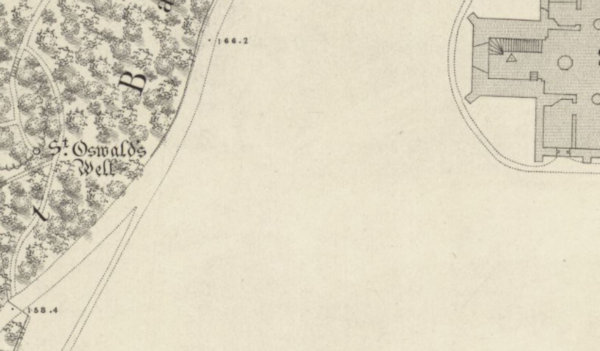 |
Dedication: Saint Oswald Location: Durham Coordinates: 54.77127N, -1.57375W Grid reference: NZ275419 Heritage designation: none |
 |
Dedication: Saint Oswald Location: Durham Coordinates: 54.77127N, -1.57375W Grid reference: NZ275419 Heritage designation: none |
St Oswald, the 7th century King of Northumbria, was particularly venerated in Durham. His relics were scattered across the country after his death, and his head was kept in Durham Cathedral, along with the remains of St Cuthbert. Oswald was seen as a particularly saintly king, and his cult became quite widespread after his death. Certainly, St Oswald's Well was directly associated with his medieval cult in Durham.
Although I have been unable to find information regarding any traditions or legends that may have been linked to St Oswald's Well, I have found some considerably early references to its existence. The well is referenced in several legal documents of the late 16th century that record the testimonies of multiple witnesses of various local disagreements and conflicts; transcriptions of these documents were published in 1845 as part of Depositions and Other Ecclesiastical Proceedings from the Courts of Durham, by the Surtees Society. In the testimony of "Henry Richerdson, of Elvett, weifer, aged 60 years", regarding a disagreement between church wardens, a section of the churchyard, "frome the corner of the Ankeridge close to St. Oswald's well", is noted to have been repaired. Likewise, the well is mentioned in the statement of Janet Surtes, regarding an incident of "fighting in the church yard":
|
She saith that, the same tyme articulat, to hir remembrance, this examinate had bein at St. Oswald well for a skeil [bucket] full of wayter, and comyng frome thens dyd se the said Gilbert and Kent over against the Ancaridge doore, in the said church yard, at what tyme the said Gilbert had a walkinge wand in his hande, and the said Kent had his dagger drawne, and Richerd Hodgson in Claputh was evon then bitwixt them. This deponent was the first that skryed them, and upon hir words, when she said and spoke on hye that yonder is a fray, then all the women that was bleaching, and such as was spynning, in the said church yard, gat on ther feit and went towerds them. And this examinat, being loden with a great skeil, went home to hir webbs. |
These accounts, that of Janet Surtes in particular, show that St Oswald's Well was still in frequent use, even if not for religious purposes, after the Reformation. Strangely, however, I have been unable to find any references to the well's existence in the 17th of 18th centuries, so it may have fallen out of favour slightly later on.
By the 19th century, the site had simply become a scenic landmark. In A Thousand Miles of Wandering in the Border Country (1898), Edmund Bogg described it as "a most romantic spot", at which "a spring bursts from a narrow cavity in the rock, o'erhung with trees", which perhaps reflects the role that the site took on after the Reformation, as an attractive feature of the landscape with little religious significance. St Oswald's Well certainly does appear to have been of little significance to at least some of the population, as the well was attacked by vandals in the 19th century.
Today, the well can still be seen at the western edge of the churchyard, issuing from, just as Bogg described, a cavity in the rock.
|
Access: The well is accessible from the churchyard. |
Images:
Old OS maps are reproduced with the permission of the National Library of Scotland
Copyright 2025 britishholywells.co.uk